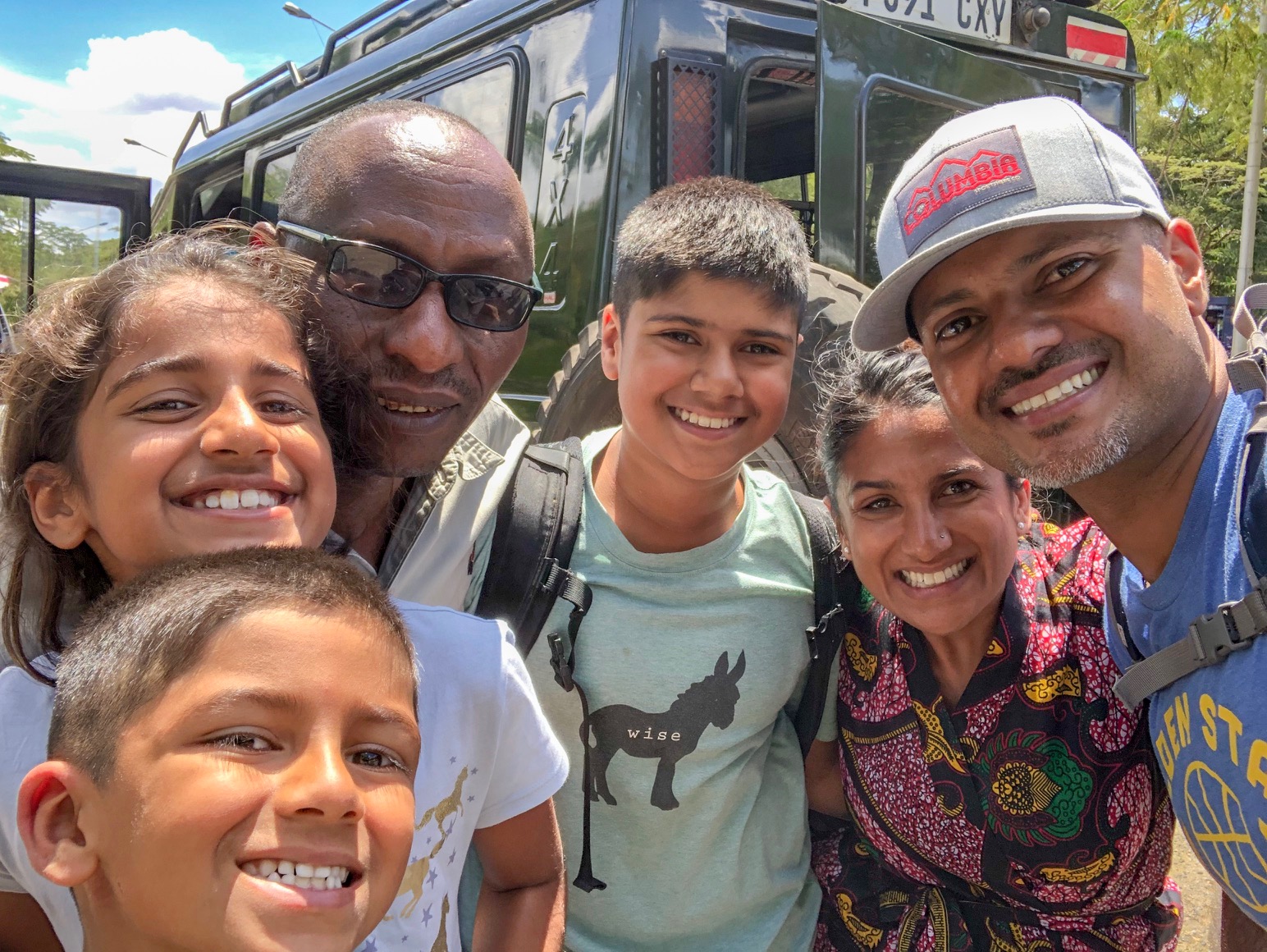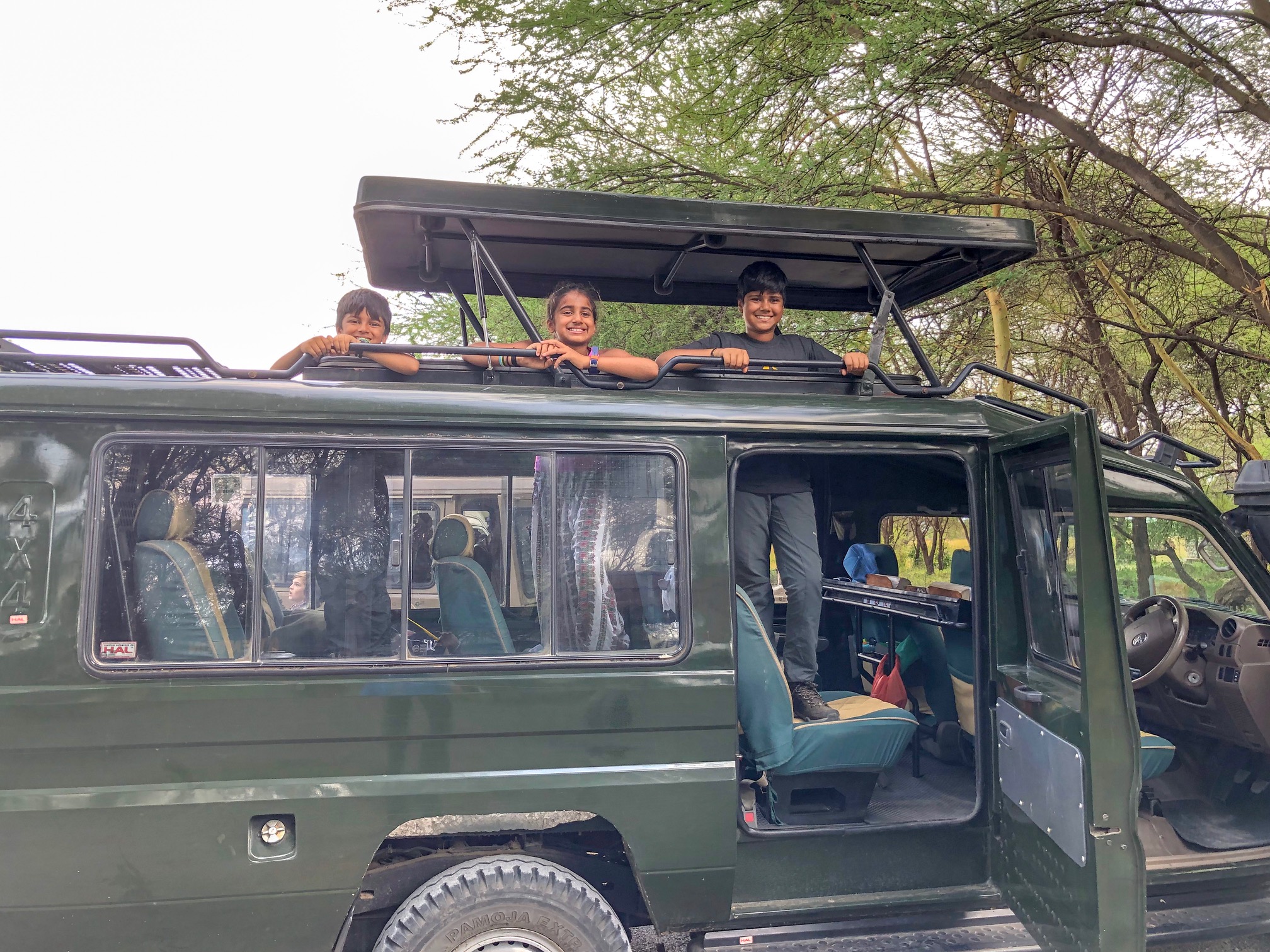Traveling Tanzania
This post is a compilation of Kenza’s (age 9) journal entries from March 2019, with minor editing support. These entries, together, show how the kids are processing their traveling/developmental hardships, while absorbing new experiences of nature and culture. The context before each entry are our parental perspectives, which make the entries that much more precious to us.
We were at our final lodge, outside of Arusha, after spending almost two weeks on daily safari in Tanzania. Kenza was still deciding on whether she wanted to go home early (an option we gave her) and skip the three-week Himalayan hike in Nepal that she felt very nervous about . Her conflict stemmed from her desire to skip Nepal but join-in on exploring Japan and other parts of Asia. Specifically in that moment, the kids had been playing for over an hour (building amazing pillow forts—see picture below) and some fight had just ensued about the amount of pillows each could use. She needed space from her brothers so she took her journal and sat next to a river for about an hour. When she came back to the room, she proudly showed us this piece.
Drawing inside the pillow fort on our last day in Tanzania.
—-
The Living River
The thing that I like most about rivers is the way that they never stop moving, no matter what. No matter what gets into it, no matter what pollutes it, or how it feels, it always keeps moving.
Sometimes I wish I could be a river always hard-going, being unsure but moving on anyway…and that having that gratifying feeling when you finally reach the ocean.
But the water isn’t what makes a river; it’s the current that keeps them moving in the toughest or hardest of times. A river is not just a river. No, it is much more than that—it is a living river.
On her first Christmas, when Kenza was one month old, Santa gave Kenza a small toy lion, which she later named “Yayo” when she could talk (because she couldn’t pronounce the word “lion” correctly). Kenza was a great sleeper from the start but she always slept with Yayo; and when she was older (like 6 months), her sleep routine included a tight swaddle with Yayo covering her eyes and a pacifier in her mouth! Yayo is as much a part of our family as anyone, and all of our extended family members know Yayo pretty well (even through all of his refresher makeovers from when he “magically visited” the North Pole about four times and came back looking like a brand new lion toy, with fresh color and softness)! Anyway, Yayo is traveling with us and LOVED Tanzania because he has been visiting all of his relatives!
All of this is to say, Kenza’s love for exotic animals (especially stuffies) came at an early age and seeing the “real” things in nature moved her in a way that none of us expected. To observe her connection with nature and her desire to instill this in her own family one day, fills our hearts with inexplicable pride and gratitude.
—-
Tanzania Safaris
When we went to Tanzania, I felt the most connection to the wildlife that I had ever felt. During our trip we learned about different cultures like the Maasai people and saw tons of animals. We loved seeing the circle of life and the secret connection between all living things, but most of all, it was being together that really made this trip beautiful.
On our safari we saw all of the “Big 9” (lion, rhino, hippo, cape buffalo, elephant, leopard, giraffe, zebra, and cheetahs)—well, I only the butt of a leopard and the rhino was really far away, but we all still thought that no matter what we have seen and learned, it is the journey that counts.
A really cool experience for us was that throughout our two weeks in Tanzania, we either stayed next to, or even inside, national parks. Every night we would need a Maasai guard to walk us to our rooms, carrying huge spears, in case an animal approached us in the dark.
We went to four national parks—Tarangire, Manyara, Ngoro Goro Crater, and Serengeti). All of them were really nice but my favorite was the Serengeti National Park because we saw our first cheetahs, a lot of lions, and a bunch of my new favorite animals, the Thompson Gazelles. Most of all, I was glad to see how well all of the elephants were doing. I was glad to see the all of the elephant families because in the 1980s elephant ivory poaching was more profitable than drug-dealing, and during that time almost 80% of the population was completely wiped out. Then around 1990 all of the major places that ivory was bought (Hong Kong, USA, Japan, and Europe) decided to lower the value and since then the regrowth of the elephant population has been going smoothly. Did you know that elephants eat 16 hours (out of the 24 hours) a day? This means that they only sleep for four hours every day!
As a family, we had a contest of who could spot the most animals. Of course, because of my pretty bad eyesight, I only spotted one thing. The animal I spotted was the serval cat. I was just thought it was a normal cat until I read more about it. Did you know that serval cats can jump so high that they can catch birds in flight? Also, because of their hind legs, they can move so fast that they can catch even the fastest frogs! As my mom says, “they are kind of built for everything!”
All in all, this trip has been so fun and pretty and I cannot wait to come back and visit Tanzania with my kids one day, so that they can really see how nature works. Fair or not, nature is always around us and inside us and that is something that we, most definitely, cannot forget. Wherever we are or whatever we are doing, we must not forget nature!
When Kenza was three years old, she used to tell us vivid stories about her three “aunties who lived in Africa” who would tell her stories and that they have lots of Halloween candy and treats waiting for her. We have NO IDEA where this concept came from, but these imaginary aunties were very much part of her world for a solid year! She doesn’t have a memory of these aunties anymore, but I know we have a video of her describing them, somewhere. The point is, Kenza has always had a global family connection to her “real” family members in Asia and the Middle East, AND now her “imaginary” aunties in Africa are becoming real too. With culturally immersive experiences in Tanzania, Botswana, and meeting all the amazing role models and new friends throughout our travels, Kenza has an expansive support network.
In Tanzania, a home to 120 different tribes, we became very close to our Maasai guide, Lesikar. We learned a lot about his culture—though he is “modern Maasai” —far more than any journal entry can recount. We also learned from the Chaga, Mbulu, and Makonde people, and tried to learn as much Swahili as we could! The journal excerpt below, however, is about Kenza’s experience of spending also the day with traditional Maasai from the Molell clan. What is extra cute about this post, is that in homeschool, Kenza had just learned about the mechanics of dialogue and quotations when writing…the ending made me smile :)
The Maasai Village
When we went to see a Maasai Village, we were feeling more than welcome. The Maasai Village, or “Boma” (in Swahili) that we went to was about an hour away from our lodge. When we arrived to the village, we were very welcomed by the son of the chief, Ole (like the beauty brand, Olay). Very soon after that we were pulled into a traditional welcome dance (again, feeling more than welcomed). We joined-in and the village started doing another dance where the Maasai men jumped really high and the women (the group that I joined) wore a wide necklace that they would flick up with their chest and shoulders while they sang. After the dancing, they showed us how they make fire from sticks.
Top Row: Shows the small school hut for the Maasai preschoolers (that opt into school); Middle Row: Pictures of the Boma which features separate huts that the wives build; Last Row: (Left) Example of crafts that the Maasai were selling; (Right) The welcoming dance with women of the village.
We were welcomed into one of the women’s homes. The home was made out of wood, straw, and poop of elephants and cows (but the house didn’t smell like that). Inside of the house, there were two beds, one for the kids and the other for the wife and husband (both with cow skins for mattresses). The cooking was done in the main part of the village as a group. Outside of the house, there was a table with some of their handmade goods to support the village with fresh water (which they bought); and of course, we each bought a little something.
This is the inside of one of the Maasai homes.
The last place we went to in the village was a school. The kids were all very cute, especially one girl that counted to 50 and then to 100 by tens. The school was for kids aged 4-6 years old, but because of the cost ($80 USD per student per year) not all of the kids go to primary school. We felt good to help and donate two scholarships for next year. The other thing is many parents don’t send their kids to primary school because they think it is too modern and the traditional Maasai culture will be lost. Plus, the walk to the school is 5km each way.
Before we said goodbye, we tried to throw a “sticky” at a goat skin tied between trees. It is literally a stick and what young warriors use to train with before they get a spear. It was hard to throw straight and many of the boys were better than all of us, even Daddy. Then (of course) we said goodbye and hopped in the car.
“Well,” I said, “that was fun!”
—-
Note: If you are reading this post on email, click “read on” to go to the website so that you can click on picture link for the Instagram post to see the additional pictures, or visit Instagram directly from our website icon or searching @franklin_street_globetrotters . You can also see some animal and Maasai video footage and additional pictures on the Instagram Stories of each of the countries referenced (click on the circle country flags at the top of our Instagram page).























